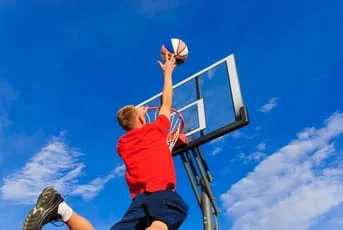
A shoulder separation is an injury to the capsule, fibers, and ligaments that get stretched beyond the plastic barrier. A fall on the point of the shoulder is the typical mechanism for a shoulder separation.
A direct blow to the shoulder or a fall on an outstretched hand may also produce one. Football and hockey are common sports associated with shoulder separations.
Treatment depends on the severity of the separation. Adjustments, bracing, taping and in grade III separations, surgery may be indicated.
Symptoms:
- Local pain over the front of the shoulder
- Joint may pop and click with movement
- Affected joint may protrude higher than the unaffected joint
- Pain increases when the arm dangles
Rotator Cuff Syndrome:
A common injury of the shoulder joint involving a tear or multiple tears of the rotator cuff muscles--a team of muscles and connecting tendons that attach your upper arm to your shoulder blade. A tear may be due to a fall on an outstretched arm, overuse, impingement, or minor stresses in the elderly. The rotator cuff helps to stabilize the shoulder throughout all its motion.
Symptoms:
- Painful or painless weakness in the shoulder
- Pain on the outside of the shoulder possibly radiating down into the arm or front of the neck.
- Pain in the shoulder, which is worse at night.
- Stiffness in the shoulder joint.
Thoracic Outlet Syndrome:
Thoracic outlet syndrome is a compression of the bundle of nerves originating in the neck or the subclavian artery. The compression can be due to a tight muscle in your neck, an extra rib, a misaligned clavicle, or a tight chest muscle resulting from poor posture, or subluxation of the cervical vertebrae. Thoracic outlet syndrome affects the shoulder, arm, hand or all three locations. The hand pain is usually most severe in the fourth and fifth fingers. The pain is aggravated by the use of the arm, and "fatigue" of the arm is often prominent.
Symptoms:
- Hand, arm, shoulder and neck pain
- Numbness and tingling of the neck arms and hands into the arm or front of the neck.
- Muscle Weakness
- Reflex Loss
- Hot and cold sensations
- Swelling
Tennis Elbow/Golfer’s Elbow:
Tennis elbow and golfer’s elbow is an inflammatory reaction due to tears in the tendons that connect to either side of the elbow. This can be due to trauma, micro trauma, overuse, chronic strain or sports/occupational injuries of repetitive stress. Treatment includes ice massage, bracing, modalities, adjustments, stretching/strengthening, myofacial release and rest. Talk to your local club pro about how to correct your swing to prevent re-injury.
Symptoms:
- Pain on the outer/inner side of the elbow and down the forearm.
- Swelling, redness or feel warm to the touch.
- It may hurt to grip things, turn your hand, or swing your arm.
Iliotibial Band Syndrome:
Iliotibial band syndrome is also known as runner’s knee. The iliotibial band runs down the outside of the thigh. When it becomes tight, the tendon starts to rub on the bone at the knee. Eventually it will become inflamed and cause pain when you run. Resting will decrease the pain, but when you run again the pain will return. Treatments include adjustments of the hip, knee, foot, examination of the gait and myofacial release.
Symptoms:
- Swelling
- Knee gives out
- Pain when you walk and/or run.
Patellofemoral Pain Syndrome: COMING SOON...
Shin Splints:
Shin splints is commonly seen as an overuse injury in runners due to muscle imbalance or hard heel strike. Pain is felt along the shin and develops gradually over a period of weeks to months. However, it may occur after a single excessive bout of exercise. Training errors and abnormal biomechanics can cause shin splints. Even more common, over pronation during gait and improper athletic shoes are culprits. Hip, knee, foot adjustments, and custom orthotics are typical treatment recommendations.
Symptoms:
- Pain begins after several minutes into athletic activity or immediately after activity
- Pain is a deep, dull ache without radiation
- Severity increases with continued stress.
Re-occurring Ankle Sprains:
An ankle sprain is a tearing or rupture of the ligaments of the ankle mortise. Many people complain of re-occurring ankle sprains or “weak” ankles. This is due to the ligament instability, weak tendons, foot misalignments, and poor balance. Adjusting the ankle along with specific strengthening exercises, we can stabilize the ankle and prevent further injury. With an acute ankle sprain, protect, rest, ice, compress, elevate and stabilize. Fractures must also be excluded.
Symptoms:
- Swelling and pain
- Difficult with weight-bearing
- Discoloration
For other sports injuries, see Treatable Conditions
